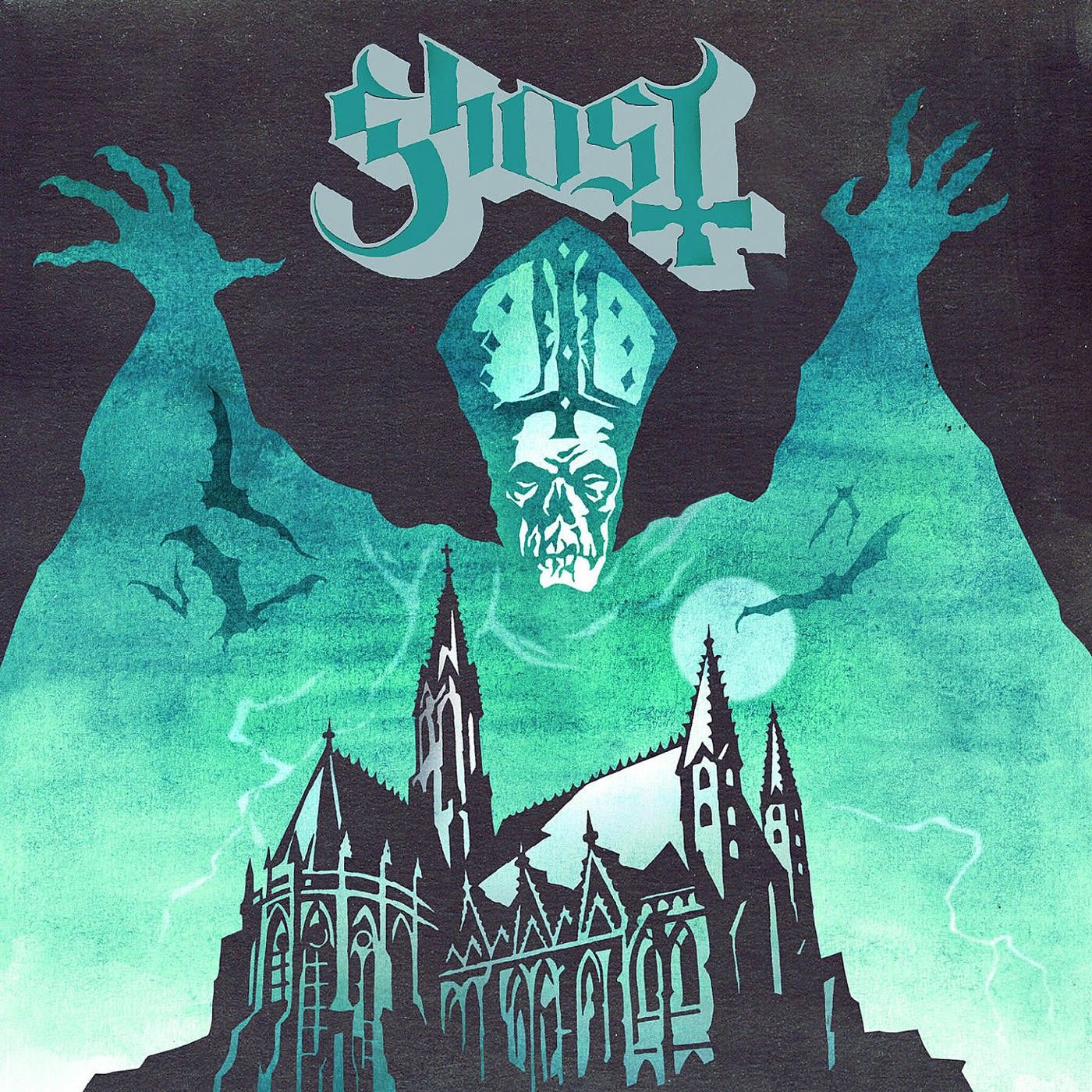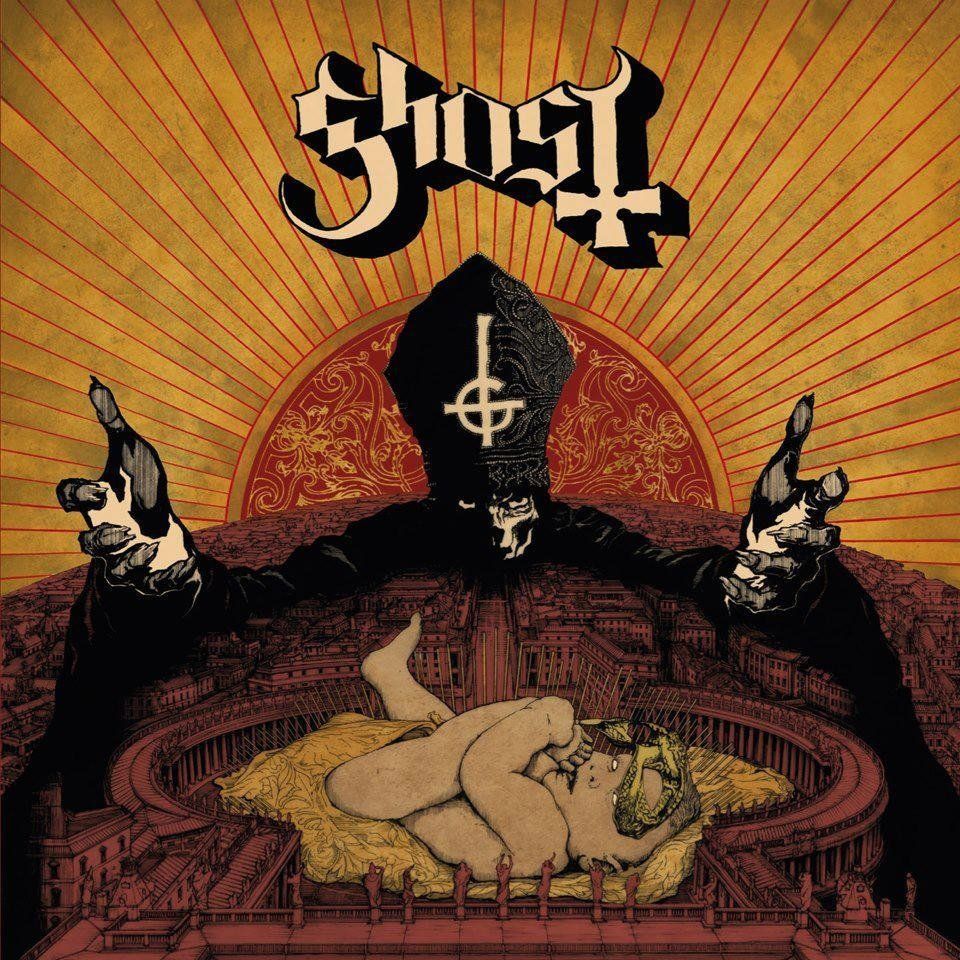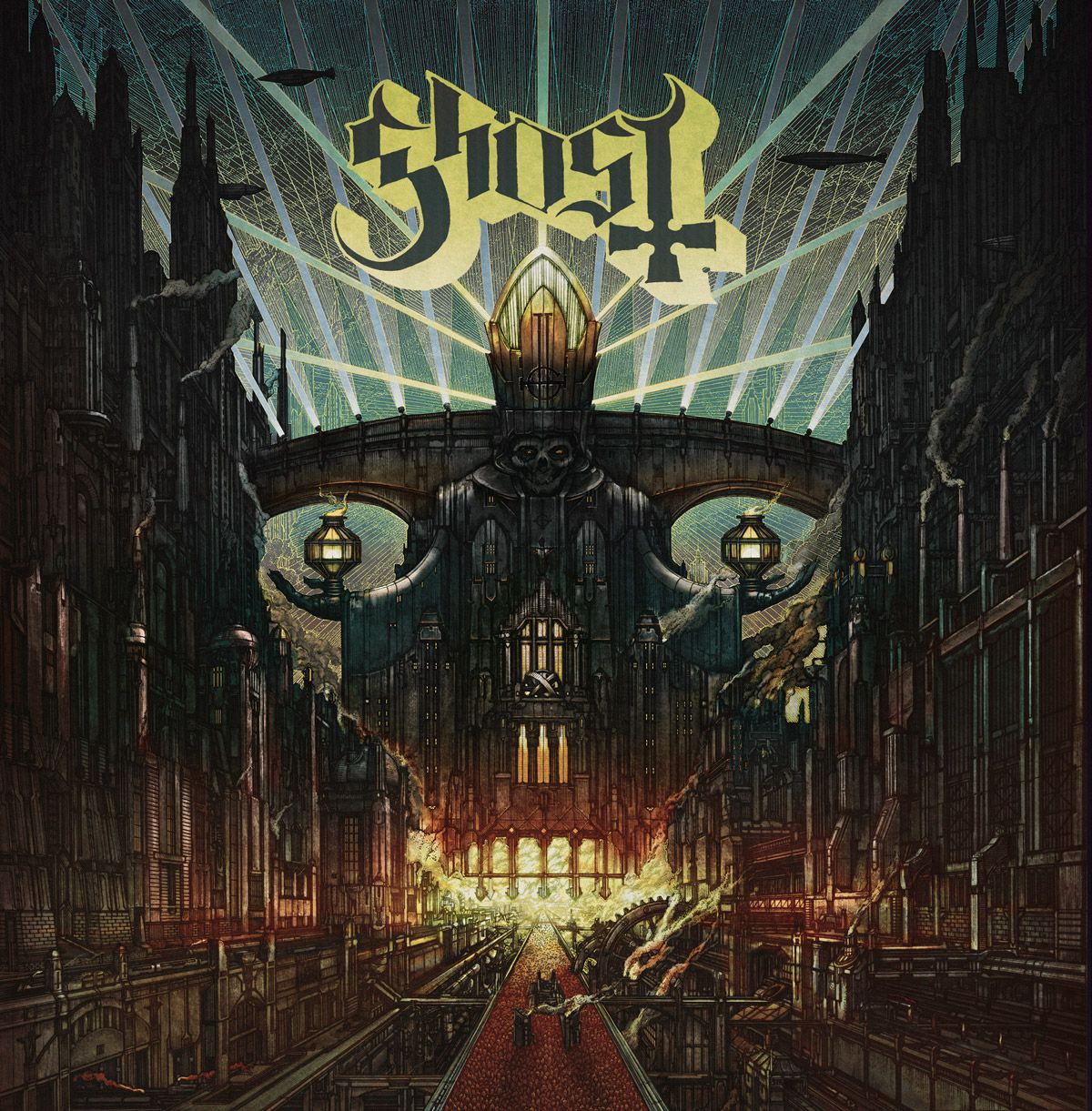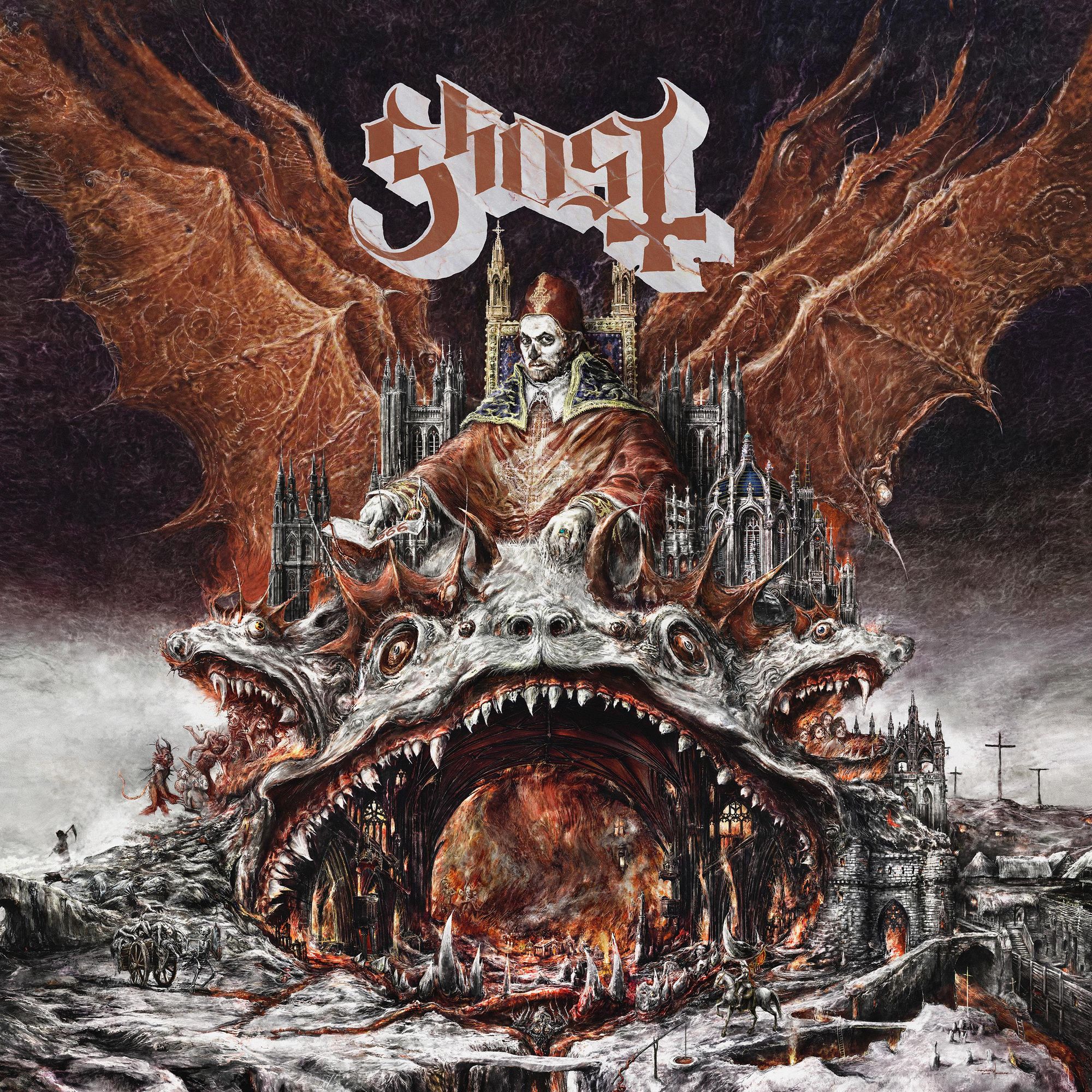A Gift to Artwork, whose name is taken from the Caligula’s Horse song “A Gift to Afterthought”, breaks down and analyses your favourite album artwork. Read other entries in this series here.
It’s hard to believe it has been over two years since we last published an article in this series. One of our first forays into the recurring columns which have proven such a hit over the past 12-18 months, it’s about time we brought this bad boy back! Jordan and I will be at the wheel and we hope you’ll stick along for the ride as it should be a great one. On that note, let’s get stuck right into analysing Ghost’s fantastic collection of album artwork! Note that the first time an album’s name appears, it will link to a large and (where possible) high-resolution image of the cover so that you can take a closer look.
Opus Eponymous (2010)

Way back in 2010 Ghost burst onto the scene with their critically acclaimed debut Opus Eponymous. The artwork is certainly intriguing, though there is little about it which immediately calls for more than a passing glance. However, if we afford it just that, we can start to unpack some meaning from it. Right off the bat, the depicted figures and overall style scream three things. Firstly, we have an undead guy, some bats, lightning and swathes of black – so chances are we’re in for something dark. Indeed, conceptually the record focuses on a sense of impending doom, with closing track “Genesis” signalling the birth of the Antichrist. Yet, at the same time, the teal colouring and cartoonish style adds some old-school levity to the piece and suggests they don’t take themselves too seriously. Finally, upon closer inspection we see that our zombie is a bishop/pope and our building is a church, so there are bound to be some religious undertones. Thus, at a glance the artwork has successfully conveyed three key aspects of Ghost’s sound and aesthetic, and there is more to find upon further inspection.
Our undead figure makes up the sky, traditionally a symbol of spiritualism, peace and heaven – all bearing quite positive connotations. Yet, he doesn’t look too impressed, striking quite a menacing pose, whilst lightning is often thought of as the punishment of the Gods. Thus, there is a dualism at play, highlighting Ghost’s tendency to straddle the line of light and darkness with their heavy lyrics and imagery juxtaposed against Papa’s vocals and their highly melodic sensibilities. Whilst it’s easy to see why many simply write the band off as Scooby Doo chase music, and this cover does little to dispel such concerns, all in all it must be said that the artwork does a fantastic job. It paints the core tenets of the band for all to see and showcases what the band have to offer – something especially crucial for a debut record.
Infestissumam (2013)

Fast forward a couple of years and we hit Infestissumam, meaning the most hostile, in reference to the coming of the Antichrist. This piece is far darker than the debut and on a much grander scale. Rather than towering over a single building, a single institution in the Church, our undead figure has invaded the city. More than this, he has become the city. And not just any city either – the circular arena and overlooking balcony marks itself as unmistakably Roman. He has consumed the Holy City itself, at once both menacing in appearance and nurturing the baby Antichrist. Further, the inverted cross on his headpiece clearly marks him as an anti-Pope, rather than any old zombie clergyman.
Further strengthening the conceptual ties we see a rising sun in the background. Firstly, Lucifer is generally translated as light bringer or morning star, and is thus closely associated with dawn and first light. Just as Satan makes his appearance on Earth, the mask highlighting there is more to him than just any child, the rising sun represents his coming. Secondly, the sunlight highlights how pervasive the evil is relative to the debut. Opus Eponymous’ cover depicted the moon, a dark sky and numerous bats, nocturnal creatures, suggesting that the anti-Pope could only use his powers at night. With the arrival of Satan, he is free to wreak havoc in the day time as well – there can be no escape.
Infestissumam’s cover does an outstanding job of pushing the concept behind Ghost’s work. However, just like the debut, it goes beyond this and offers hints as to Ghost’s sound. Whilst not as prominent as on the debut, justifiably so given they were becoming an established name, the intricately detailed sun and half-mask let the listener know that not only are they in store for some dark and satanic tunes, but some theatricality too.
Meliora (2015)

Moving onto (not even) arguably their best album, Meliora offers a fantastic cover to boot. Bielak’s piece continues to strike a great balance between offering something fresh whilst remaining inimitably Ghost’s. The anti-Pope is still a part of the city itself, though where he was once a visible invader he is now ingrained in the city’s very fabric. He has become the Church, an institution of the city, usurping God’s servants from within and offering Satan’s guidance instead. He places himself as the sole bringer of light, the city’s only guide and salvation, with even the search lights in the background emanating from his headpiece. Satan’s omnipresence is further highlighted by the Babushka-style layering, with the Church/bridge anti-Pope just forming part of a larger anti-Pope’s head.
As alluded to, in addition to consuming the Church our anti-Pope forms part of an enormous bridge. Thus, he can be seen as the bridge between life and death, light and darkness, the Earth and a spiritual world. The band have gone on record to state the central theme behind the album is the absence of God, with the band filling the resultant void. The anti-Pope, through Papa Emeritus and by extension Tobias Forge, is Ghost. Through him, the band is depicted as the sole light, the sole spiritual place to which the masses congregate. The dystopian image is completed by the tiny specs of people, crammed in like sardines as they funnel towards a Church entrance resembling the mouth of hell, flanked by towering, cold and soulless buildings. Bielak really nailed this one.
Prequelle (2018)

Speaking of nailing it – the artwork for 2018’s Prequelle is simply stunning. The detail and creativity on display is truly awe-inspiring and it’s a fantastic work of art with which to finish this article. The first thing we notice is the medieval style of the artwork, but we need no invitation to explore every nook and cranny of this piece. Cardinal Copia has replaced Papa Emeritus, the change in rank signified by the new headpiece and the red clothing. The cardinal’s throne is a gothic church, yet simultaneously an amphibian Cerberus atop a hellish landscape filled with fire and brimstone. Behind him are demonic wings furnished with cobwebs, maelstrom-like vortexes and ugly boils. Those same boils afflict the cardinal’s face, showcasing that the Black Death is one of the album’s key concepts. Fittingly we have a knight in the bottom-centre, in keeping with the plague’s period, whilst a grim reaper and a cart full of dead bodies in the bottom-left only add to this aesthetic. We could write an entire piece simply describing what the piece has to offer and we still wouldn’t get through half of it – so what else does the art tell us?
Firstly, it shows us that after three iterations, Papa Emeritus has been cast by the wayside in favour of a new lead character – a new Ghost. Secondly, it helps reveal the albums plague-inspired concept, with tracks such as “Ashes”, sporting lyrics from “Ring a Ring o’ Roses”, and “Rats” suddenly making a lot more sense. Thirdly, the medieval theme and historical concept is at odds to Meliora’s urbanised, somewhat science fiction style artwork, and this hints at the record’s sound. Whilst Ghost have always been heavily influenced by older music, the 70s and 80s influences are on display to a greater extent than ever on Prequelle. Finally, it reminds us that Zbigniew M. Bielak truly is a gift to artwork. I hope you enjoyed this column’s comeback, and we’ll see you again next month!